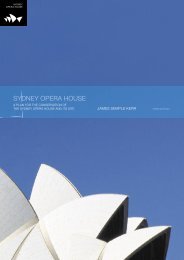Stage 3 - Sydney Opera House
Stage 3 - Sydney Opera House
Stage 3 - Sydney Opera House
- No tags were found...
Create successful ePaper yourself
Turn your PDF publications into a flip-book with our unique Google optimized e-Paper software.
Lesson Content and Teaching/Learning Activities Resources Register1 Theatre Superstitions• Elicit from students their understanding of ‘theatre’. Discuss any experiencesstudents may have had attending or performing in theatre productions.• Elicit from students the meaning of ‘superstition’. Discuss commonsuperstitions students may be aware of. E.g.• Friday the thirteenth is an unlucky day• If you walk under a ladder, you will have bad luck• At the end of a rainbow is a pot of gold• A cat has nine lives• An apple a day keeps the doctor away• Explain to students that there are a number of superstitions associated withthe theatre. Split students into small groups of 3-4 and give each group a‘Theatre Superstition’ card (multiple groups will have the same superstition).Groups are to come up with what they believe is the meaning behind thesuperstition they were given. Students should write their agreed meaningdown to share with the class.• Groups share their meanings and be given the correct reason behind eachsuperstition. Students need to have these ready to discuss in their digitalexcursion.Theatresuperstitiongroup cards–superstitionsand reason(to be put oncardboard ifdesired)Paper/JournalPencilsRubbers2 TECHNICAL ASPECTS Of THE THEATRE (RESEARCH TASk)• Students to work individually or in pairs and be selected to research either thevarious technical aspects of the theatre or Theatre History.• For the technical aspects of theatre, students should be encouraged to focuson:• Places in a theatre e.g. Greenroom, Dressing Room• Jobs in the theatre e.g. Director, actor, <strong>Stage</strong> Manager, Lighting,Ushers• For the Theatre History, students should be guided to focus on:• What was the first recognised ‘theatre’? The Theatre built in 1576 byJames Burbage• What are the most famous theatres around the world now and inthe past? E.g. The Globe Theatre, <strong>Sydney</strong> <strong>Opera</strong> <strong>House</strong>, RomanColosseum,• Why are theatres designed today the way they are?• The class should choose to collectively present their information eitherin a ‘book’ or on a large sheet of cardboard/paper. As students find newinformation they should continue to add to these resources their growingknowledge of ‘theatre’.Computer/InternetaccessJournal, paperor cardboardfor recordingideas3 STILL IMAGE (TAbLEAUx) PREPARATIONThe following activities focus on how the body can show expression bothindividually and in collaboration and balance with others. It is important to set upthe space for a drama session (see attached guidelines).SHARING EMOTION• Students form two lines facing each other across the room. One line is line A,the other line B. Give line A an emotion. On a given cue, both lines are to movetoward one another. Line A would walk demonstrating that emotion whileLine B remains neutral. As they pass, the half of the pair in Line A ‘passes’the emotion to the pair of Line B who continues crossing the room in the samemanner that their Line A pair began while the Line A student completes theircrossing neutrally.• Line B is then given a turn to show and ‘pass’ the emotion.Guidelinesfor classroomdramaStill ImagePrompt list5house:Ed 2012
















